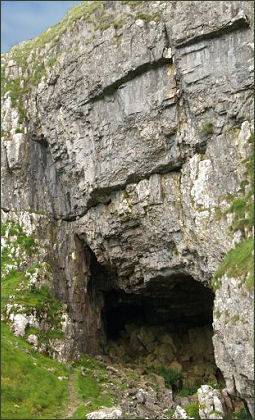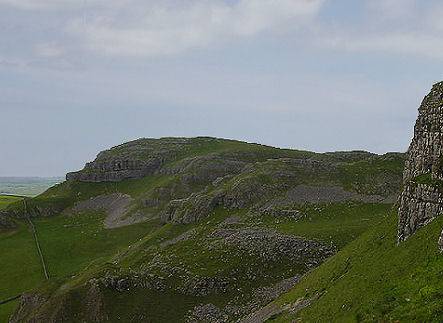Victoria Cave
OS grid reference:- SD 838 650
 Victoria Cave is situated near the market town ofSettle and to the east of the Yorkshire Dales village of Langcliffe in Ribblesdale. It was so named as the inner chamber was discovered on the day of Queen Victoria's accession to the throne on 20th June 1837.
Victoria Cave is situated near the market town ofSettle and to the east of the Yorkshire Dales village of Langcliffe in Ribblesdale. It was so named as the inner chamber was discovered on the day of Queen Victoria's accession to the throne on 20th June 1837.
The cave was discovered purely by chance by Michael Horner, a local tinsmith and mechanic. Horner was catching rabbits along with two companions when one of the hunting dogs chased a rabbit into a small opening in the rock, Horner, assuming it was stuck, squeezed through the hole and followed to find the dog. His employer Joseph Jackson, a Settle plumber, began the first systematic excavations of the cave in the autumn of 1837. It was Jackson who discoverecd the first coins amongst other artefacts.
Jackson sought the expert advice of from Charles Roach Smith, a Roman archaeologist, it was to take a further thirty years before a funded excavation of the cave was arranged. Victorian excavators were particularly interested by 'bone caves' where there may be a possibility of finding evidence for the earliest humans in Britain along with long extinct animals.
Since that time the cave has been completely excavated and has yielded a fantastic record of climate change in the Yorkshire Dales over thousands of years.
 The cave was found to contain the remains of mammoth, bear, elephants, reindeer, spotted hyena and hippopotamus as well as flint implements of which the earliest were 130,000 years old. It appears as if hyenas were using the cave as a den and dragging scavenged bones back to it. At that time, the cave's opening would have been much more narrow than it is at present and it would have an made ideal lair for wild animals; the climate was then much colder than today's and the tundra landscape around the cave would have been inhabited to many animals which are now extinct in Britain.
The cave was found to contain the remains of mammoth, bear, elephants, reindeer, spotted hyena and hippopotamus as well as flint implements of which the earliest were 130,000 years old. It appears as if hyenas were using the cave as a den and dragging scavenged bones back to it. At that time, the cave's opening would have been much more narrow than it is at present and it would have an made ideal lair for wild animals; the climate was then much colder than today's and the tundra landscape around the cave would have been inhabited to many animals which are now extinct in Britain.
In amongst the bones of reindeer was an antler harpoon point, which provides the first evidence for human habitation in the Yorkshire Dales after the last glaciation. This has been dated to within 110 years of 8270 BC, the late upper palaeolithic period. After the last Ice Age, the cave seems to have been used by hibernating brown bear. For archaeologists, the Roman layers were even more interesting. Here a collection of unusual bronze and bone artefacts were found, including brooches and coins.
Some of these items, including a female bear's skull, (which was found along with bones from a new born cub) from the caves are now on display at Craven Museum & Gallery in Skipton.
The Roman layers of the cave gave up a collection of unusual bronze and bone artefacts, including brooches, bracelets of twisted wire, amber and glass beads and pottery, some imported from as far away as France and Africa as well as several mysterious perforated bone spoons, there were also over a hundred coins which had been minted between 83 BC and 346 AD. Archaeologists have speculated for years as to what exactly was going on in the cave and it now seems likely that the inside was used as a shrine and there was a workshop area outside.
Victoria Cave is a designated Scheduled Monument and part of a Site of Special Scientific Interest. The cave is managed by the Yorkshire Dales National Park Authority.
Directions
Follow the B6478 from Settle to Horton-in-Ribblesdale. After just over half a mile turn right into Langcliffe following signs to Malham. The path to Victoria Cave commences about a mile up this road on the right, just before the car park for Winskill Stones.
Prehistoric and Roman Sites of Yorkshire
